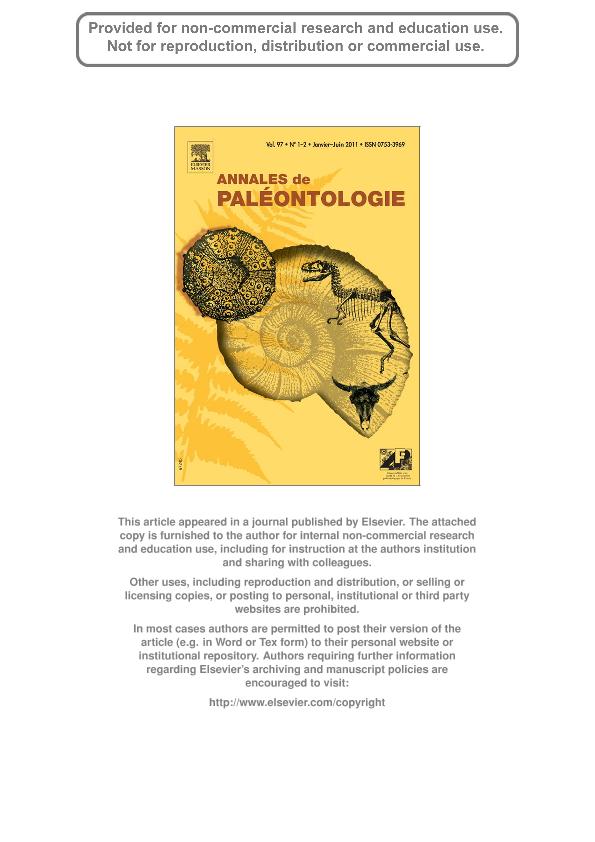Artículo
The anatomical and taxonomic knowledge of some groups of Glyptodontidae (Mammalia, Cingulata) is still very poor. In addition, a strict typological/morphological taxonomic criterion was used in recognizing many taxa, especially during the second half of the 19th century and the first of the 20th century. This particular situation resulted in a clear overestimation diversity, mainly with respect to the South American glyptodonts. In this scenario, this paper analyzes the taxonomic status of some Glyptodontinae through a precise comparative study with well characterized taxa. The main results show that the genera Pseudothoracophorus Castellanos (P. depressus) and Chlamydotherium Lund, one species of the genus “Boreostracon” Simpson (B. corondanus), and one species of the genus Glyptodon Owen (G. falkneri), actually represents juvenile specimens referable to Glyptodon Owen; the genus Neothoracophorus Ameghino (N. elevatus) could be related either to Glyptodon Owen or Glyptotherium Osborn. Another species, Heteroglyptodon genuarioi, presents an almost identical morphology compared with the recognized species of Glyptodon (e.g. G. munizi and G. reticulatus). In this sense, the diagnostic characters described for Glyptodon perforatus Ameghino, a taxon with biostratigraphic relevance since it is characteristic of the Lujanian Age/Stage (late Pleistocene-early Holocene), are also present in other species of Glyptodon, especially G. reticulatus and G. clavipes, very frequent taxa in southern South America. La connaissance anatomique et taxonomique sur certains groupes de Glyptodontidae (Mammalia, Cingulata) est encore très limitée. En effet, un critère strictement typologique/morphologique a été employé pour reconnaître beaucoup de taxons, spécialement pendant la seconde moitié du xixe siècle et la première moitié du xxe. Cette situation particulière a donné comme résultat une très nette surestimation de la diversité, surtout en ce qui concerne les glyptodontes sud-américains. Dans ce scénario, cet article analyse le status taxonomique de quelques Glyptodontinae au travers d’une étude comparative précise avec des taxons bien caractérisés. Les résultats principaux montrent que les genres Pseudothoracophorus Castellanos (P. depressus) et Chlamydotherium Lund, une espèce du genre « Boreostracon » Simpson (B. corondanus), ainsi qu’une espèce du genre Glyptodon Owen (G. falkneri) représentent en fait des spécimens juvéniles qui se réfèrent à Glyptodon Owen ; le genre Neothoracophorus Ameghino (N. elevatus) pourrait correspondre à Glyptodon Owen ou Glyptotherium Osborn. Une autre espèce, Heteroglyptodon genuarioi, présente une morphologie presque identique comparée aux espèces reconnues de Glyptodon (par exemple G. munizi et G. reticulatus). De même, les caractères diagnostiques décrits pour Glyptodon perforatus Ameghino, espèce à intérêt biostratigraphique parce qu’elle est caractéristique de l’étage Lujanien, (Pléistocène tardif-début Holocène), sont aussi présents chez d’autres espèces de Glyptodon, particulièrement G. reticulatus et G. clavipes, espèces très fréquentes au sud de l’Amérique du Sud.
On the taxonomic status of some Glyptodontidae (Mammalia, Xenarthra, Cingulata) from the Pleistocene of South America
Título:
Sur le statut taxonomique de quelques Glyptodontidae (Mammalia, Xenarthra, Cingulata) du Pléistocène d’Amérique du Sud
Zurita, Alfredo Eduardo ; Oliveira, Edison Vicente; Torino, Pablo Adrián; Rodriguez Bualó, Santiago Martín
; Oliveira, Edison Vicente; Torino, Pablo Adrián; Rodriguez Bualó, Santiago Martín ; Scillato, Gustavo Juan
; Scillato, Gustavo Juan ; Luna, Carlos; Krapovickas, Jerónimo Matías
; Luna, Carlos; Krapovickas, Jerónimo Matías
 ; Oliveira, Edison Vicente; Torino, Pablo Adrián; Rodriguez Bualó, Santiago Martín
; Oliveira, Edison Vicente; Torino, Pablo Adrián; Rodriguez Bualó, Santiago Martín ; Scillato, Gustavo Juan
; Scillato, Gustavo Juan ; Luna, Carlos; Krapovickas, Jerónimo Matías
; Luna, Carlos; Krapovickas, Jerónimo Matías
Fecha de publicación:
06/2011
Editorial:
Elsevier Masson
Revista:
Annales de Paleontologie
ISSN:
0753-3969
Idioma:
Inglés
Tipo de recurso:
Artículo publicado
Clasificación temática:
Resumen
Palabras clave:
Glyptodontidae
,
Juvenile Specimens
,
Ontogeny
,
Osteoderms
,
South America
,
Taxonomy
Archivos asociados
Licencia
Identificadores
Colecciones
Articulos(CCT - LA PLATA)
Articulos de CTRO.CIENTIFICO TECNOL.CONICET - LA PLATA
Articulos de CTRO.CIENTIFICO TECNOL.CONICET - LA PLATA
Articulos(CECOAL)
Articulos de CENTRO DE ECOLOGIA APLICADA DEL LITORAL (I)
Articulos de CENTRO DE ECOLOGIA APLICADA DEL LITORAL (I)
Citación
Zurita, Alfredo Eduardo; Oliveira, Edison Vicente; Torino, Pablo Adrián; Rodriguez Bualó, Santiago Martín; Scillato, Gustavo Juan; et al.; On the taxonomic status of some Glyptodontidae (Mammalia, Xenarthra, Cingulata) from the Pleistocene of South America; Elsevier Masson; Annales de Paleontologie; 97; 1-2; 6-2011; 63-83
Compartir
Altmétricas



